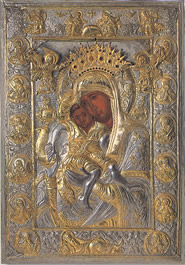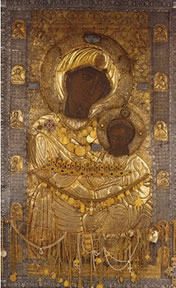Wim van Loon was one of six speakers accompanying the 2013 exhibition, ‘Icons from Eikonikon’, held at the Stedelijk Museum in Vianen, a town in the Netherlands. Van Loon, a former editor of the magazine, ‘Eikonikon’, and a frequent visitor to the Greek monasteries on the peninsula Athos, opened the proceedings with a lecture on the Holy Mount Athos, also referred to as the Garden of the Mother of God. The theme was very appropriate as an eponymous exhibition was organized in the museum’s own garden. The article which follows is an excerpt from his lecture and focuses on two renowned Athos icons, ‘Mother of God Karyótissa’ or ‘Axión Estín’ and ‘Mother of God of Iviron’ or ‘Panagía Portaítissa’.
At the annual ceremony inaugurating the new administrative body of Athos, the Holy Supervisory Committee of the Community (Hiera Epistasia), a traditional photograph is taken of the monks against the majestic background of the Church of the Protáton on Mt Athos in Karyes. The 9th century church, dedicated to the Dormition of the Blessed Mother Mary, was the first built on the holy mountain and houses 13th century frescoes attributed to the Byzantine iconographer, Emmanuel Pansélinos.
 But the church is perhaps more renowned for the most famous icon of Mt Athos, Mother of God Karyótissa, known affectionately throughout Greece as ‘The Miraculous IconAxión Estín’. It is an exceptional work of art; not for its special style or the technique used in creating it, nor even for its monetary worth. Its true value lies in the icon’s meaningful significance and deeply religious importance. Its proper place is behind the iconostasis of the Protáton, on a synthronon or marble throne in the sacred Holy of Holies. In the shadows of the soft glow of candlelight, the Mother of God Karyótissa is greeted and revered by pilgrims and worshipers. While under restoration in 2013, the icon was placed in the middle of the church.
But the church is perhaps more renowned for the most famous icon of Mt Athos, Mother of God Karyótissa, known affectionately throughout Greece as ‘The Miraculous IconAxión Estín’. It is an exceptional work of art; not for its special style or the technique used in creating it, nor even for its monetary worth. Its true value lies in the icon’s meaningful significance and deeply religious importance. Its proper place is behind the iconostasis of the Protáton, on a synthronon or marble throne in the sacred Holy of Holies. In the shadows of the soft glow of candlelight, the Mother of God Karyótissa is greeted and revered by pilgrims and worshipers. While under restoration in 2013, the icon was placed in the middle of the church.
The icon is sheathed in a silver riza (Russian for robe), a term often translated into English as revetment and a practice begun in the Byzantine period. With the exception of the faces of Mary and the Child Jesus, the icon Mother of God Karyótissa is completely encased in the protective riza. Years of smoke from the candles and incense lit in veneration, have discolored and darkened their features. The miraculous Axión Estín belongs to the Eleoúsa or ‘Virgin of Loving Kindness’ category of icons and, more specifically, a Glykofiloúsa icon, Greek for ‘Sweet Loving’. Part of the reason this icon is special is that more commonly the Child Jesus appears on the Virgin’s left arm, the Mother of God Karyótissa embraces him with her right arm.
Legend has it that in the 10th century, the Archangel Gabriël appeared to a hermit monk and, standing before the icon, sang the opening stanza of a hymn chanted to date in Orthodox liturgy, “O Theotokos (Axión Estín), it is truly meet to bless thee, ever blessed, and most pure, and the Mother of our God”. The Mother of God, radiant in a heavenly glow, smiled approvingly and exchanged positions with the Christ Child, placing him on her right. This miraculous apparition is credited with bestowing the icon’s time-honored moniker, Axión Estín. The miracle is purported to have taken place on 11 June, 892 CE and is ascribed as the beginning of the establishment of monasteries and cloisters on Mt Athos, many in her honor.
Another miracle is reported to have taken place in the 8th century, during the iconoclasm in Constantinople. The legend tells of a soldier in the service of the emperor who slashed at the icon, and at that moment, blood started to flow from the icon into the nearby sea. Shocked by this apparent sign, the repentant sinner fled to the monks on Mt Athos. One day he found the icon on the beach; she was still bleeding and turning the sea around the peninsula blood red. In trembling arms, he tenderly carried her, rushing to the church in Karyes. Once there, the blood stopped flowing and the soldier felt this sign meant that, mercifully, his iconoclastic act had been forgiven. In great gratitude, the monks gathered and chanted the Hymn of Axión Estín. Since then, this ode to Mary is sung daily in the Protáton.
It is only under the most extraordinary circumstances that Axión Estín leaves the Holy Mountain. One such occasion, the very first, was the thousand-year anniversary of Mt Athos in 1963 when the icon was venerated in Athens. When an earthquake hit the peninsula in 1999, hundreds of thousands of believers welcomed her in regal glory in Athens.
Panagía Portaítissa
The narrative of the second acclaimed Athos icon, Panagía Portaítissa, begins in the period of the Byzantine Iconoclasm. During this time, a widow from the then-Asia Minor city of Nicosia (now Turkey) had a large, magnificent icon of Panagía Hodigetrea. By royal edict of Emperor Theophilus, an iconoclast, soldiers were sent to the widow’s house.
 One of the soldiers stabbed the image with his sword and blood flowed from the wound on the Panagía’s cheek. Stunned by the miracle, he fell to his knees in remorse. The soldier repented, ceased in his pursuit of icons and entered a monastic order. On his advice, the woman hid the Panagía Hodigetrea to prevent further desecration to the icon.
One of the soldiers stabbed the image with his sword and blood flowed from the wound on the Panagía’s cheek. Stunned by the miracle, he fell to his knees in remorse. The soldier repented, ceased in his pursuit of icons and entered a monastic order. On his advice, the woman hid the Panagía Hodigetrea to prevent further desecration to the icon.
The destruction of icons continued and the widow slipped away with the Panagía Hodigetreaand placed it in the sea, confident in her deep belief that this was what the Mother of God wanted and that it would be saved. Her prayers were answered and the icon remained upright and began to drift in a westerly direction. Her son was also forced to flee to the West to avoid prosecution. He later became a monk and died on the north coast of the holy Mt Athos, close to the Cloister of Klimentos, now the Holy Monastery of Iviron. During his lifetime, he recounted his mother’s story of the miracle of Panagía Hodigetrea and the legend has been passed on from one generation of monks to the other.
Many years later, the icon appeared in the sea around the peninsula of Mt Athos. According to a time-honored account, the awe-struck monks from the Monastery of Iviron observed an amazing phenomenon; a radiant column of light shone from the icon and beamed in the direction of the heavens. One brother in the community, Gabriël, had an apparition from the Mother of God who requested him to retrieve the icon from the sea. In the vision she said he should convey to the monks that she wished to give assistance and become the protectress of the monastery. She told Gabriël not to fear but to go to the icon and, in his own hands, bring it to the monastery. Athonite tradition relates that, obedient to the declaration of the Mother of God, “Gabriël walked upon the waters as though upon dry land”, picked up the icon and brought it back to the shore. The monks carried the Panagía Hodigetrea to the monastery and placed it upon an altar.
Despite its place of honor in the katholikon, the Panagía Hodigetrea repeatedly disappeared from the altar and was continuously found above the gate facing the inside of the monastery. In a dream, the Blessed Mother told Gabriël she had chosen this place to protect the monks, not to be protected by them. In this way, the icon was given the designation Panagía Portaítissa, Greek for “she who resides by” or is “keeper of the gate”. To this day, her presence in the monastery and on the Holy Mount Athos is a pledge of the protection of Theotókos to all monasteries of Athos. A special chapel for the Panagía Portaítissa was later built near the wall of the monastery.
Although the traditional name of the icon is Panagía Portaítissa, in recent times the icon has become known by the Russian and American Orthodoxy as the Mother of God of Iviron, reflecting the monastery where it is housed. Also known by the name, Theotokos Iverskaya,tradition holds that this miraculous icon was painted by the apostle and evangelist, Saint Luke.
The holy icon, Panagía Portaítissa, is only removed from her place of honor in the chapel twice yearly. In the Eastern Orthodox Church, days in the period of Easter have a special name; on Bright Tuesday, the first Tuesday after Easter and the day the Eastern Orthodox community believes the icon arrived on the Holy Mount of Athos, the Panagía Portaítissatakes part in a liturgy in the chapel on that spot by the seaside. The second time the icon leaves the chapel is on 15 August, the Dormition (Falling Asleep) of the Theotókos also called the Assumption.
The Panagía Portaítissa has never left the Holy Mount Athos nor has it gone out of the boundaries of the Monastery of Iviron.
By Wim van Loon
(Translated by Lorraine Weber)